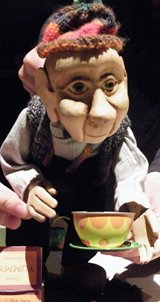Theatre for children and young people occupies a spectrum that ranges from the didactic (more frequently the domain of the adolescent productions) to the magical, aimed at a younger age-group. An Seanfhear Beag is unequivocally on the side of the magical and it ticks almost all the boxes for children’s theatre of the highest order, drawing on both local and national influences: it is Irish, in that the few words employed in the course of the action are Gaelic; it is European in that the company took a child’s story from Sweden (by Barbro Lindgren) and transposed it to an Irish village. Branar chose, as their mentor, Bjarne Sandborg of Teater Refleksion, Denmark, clearly a master of story-telling and sparse theatrical subtlety; and they found a talented Galway (German-born) puppet-maker, Suse Reibisch, to develop the characters.
The social context is a vindictive place, a kind of village of squinting windows, where every move of the seanfhear is plotted, briefly sentimentalized and ultimately derided by voices coming from the row of miniature houses set above the main action.
This is magic of a high order – not based on smoke and mirrors or the phantasmagorical, but on a closely-observed account of the human need for contact.
It is breathtakingly serene. From Morgan Cooke’s ethereal music – melodika, flute, citre and wine glasses, all demanding an attentive ear - to the meticulously-observed movement of the old man, this is deceptively simple story-telling – solitary individual befriends dog – which touches minds and hearts from five-years-old to infirmity. The uncompromising commitment to allowing the tale unfurl, in a gentle, unhurried fashion, respecting the very texture of solitude (in Irish, that emotive word uaigneas), makes it an affecting piece of theatre.
The stillness of the seanfhear sitting on his doorstep, or going about the lone task of watering his flowers gives a piecing sense of his exile. The whisking-tailed madra that erupts into his life, followed later by the cailín and her kite (eitleog), demonstrates that life can be turned around. If the old man’s gait and fixed facial expression - superbly crafted by Reibisch - conveys a deep and unspoken sadness, the woolly anarchy of an madra, all agitation and energy, and the lightness of the kite, expresses hope and optimism.
 This play evokes the human condition at multiple levels and, by its concentration, commands wonder and reflection. That sense is compounded by the visibility of the humans. (It is interesting that these were not puppeteers of long standing, rather actors who learnt this medium because it was the one they felt best told the story.) Their intense, silent focus on the work, their apparent identification with their puppets - the agitation of Máire Greaney Daly’s hands corresponding absolutely with the exuberance of an madra; the deliberate and delicate manipulations of an seanfhear by Marc MacLochlainn are an extension and an elaboration of the old man’s character - give an added articulation to the presentation. This is magic of a high order – not based on smoke and mirrors or the phantasmagorical, but on a closely-observed account of the human need for contact.
This play evokes the human condition at multiple levels and, by its concentration, commands wonder and reflection. That sense is compounded by the visibility of the humans. (It is interesting that these were not puppeteers of long standing, rather actors who learnt this medium because it was the one they felt best told the story.) Their intense, silent focus on the work, their apparent identification with their puppets - the agitation of Máire Greaney Daly’s hands corresponding absolutely with the exuberance of an madra; the deliberate and delicate manipulations of an seanfhear by Marc MacLochlainn are an extension and an elaboration of the old man’s character - give an added articulation to the presentation. This is magic of a high order – not based on smoke and mirrors or the phantasmagorical, but on a closely-observed account of the human need for contact.
Derek West has reviewed theatre for almost 25 years. He also edits publications for NAPD, the school principals’ national organisation.